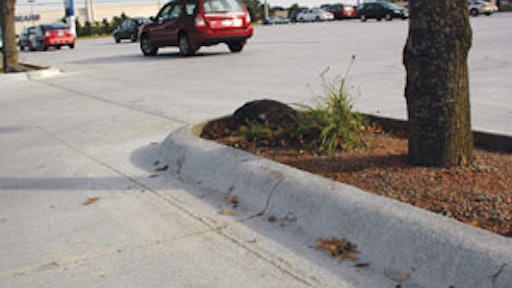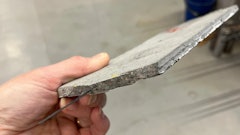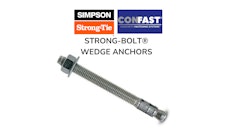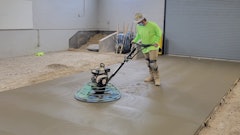
The rivalry between concrete and asphalt has become a classic contention, much like the climate in a Wisconsin bar during a Packers vs. Bears match-up or in the stands at a meeting of the Yankees and Red Sox. Historically, concrete has been seen as the underdog in this battle, going up against a material that's the perceived leader for parking lots and roads. But as asphalt prices rise and the concrete industry works on paving promotion, opportunities are opening up for owners to more clearly see the benefits of concrete.
A concrete parking lot offers owners several benefits over asphalt. For one, it has a lighter surface which reflects more light. This creates a brighter and safer parking lot and allows owners to save on energy bills with lower wattage lighting. The popularity of LEED-certified projects has opened doors for concrete because of its low albedo, or heat absorption, and help in lessening the heat island effect. Maintenance needs are also lower and concrete pavements are expected to last at least 20 years, resulting in a better life-cycle cost over asphalt.
In recent years, the industry has seen an increase in popularity of both full-depth concrete paving and whitetopping, a technique in which contractors pave a layer of concrete over an existing pavement such as asphalt. Whitetopping is less expensive than full-depth concrete paving and a much quicker and easier process for a contractor to perform. The National Ready Mixed Concrete Association (NRMCA) hopes concrete parking lots will have a 15 percent market share by 2010, up from 9 percent in 2005.
A recent mall parking lot whitetopping job by Docken Concrete of Verona, Wis., exemplifies the trend in the industry. The owner of the property already had one concrete parking lot and knew the advantages of concrete. "I get a better total product out of concrete," says Jim Grafft, president of Grafft Investments and owner of the Janesville Plaza. "Concrete doesn't have the maintenance issues [blacktopping does] and there's a better perceived value with concrete."
Grafft says he chose whitetopping for his parking lot because with the existing asphalt base he can take advantage of the strength of both the old pavement and the new one. The slightly higher cost for the whitetopping, $0.66 more per square foot than asphalt, presented an easy decision for Grafft. "When I compared one to the other, I felt I was getting very good value with the price of asphalt where it was. The extra money I spent on the concrete well offset the price of asphalt. It was a value thing," he explains.
Docken Concrete is a commercial and industrial flatwork company in south central Wisconsin. The company has been performing concrete paving since the early 1990s on projects such as heavy truck turnarounds and receiving areas at distribution plants and big box stores. It also performed full-depth concrete parking lot paving at some of these jobsites. The 100,000-square-foot whitetopping project at Janesville Plaza was the company's first foray into this increasingly popular type of concrete work.
Scott Docken, vice president of Docken Concrete, says the price increase of asphalt over the last year has put concrete and asphalt closer together in initial price, making it easier for owners to see the life cycle benefits of concrete over asphalt. "You're not comparing two equal things when you look at concrete and asphalt. You get a better end result with concrete," he says. Docken adds that concrete parking lots hold up better to heavy traffic. "Asphalt is an excellent base, and it's pre-existing so there is no waste," Docken says. "Trouble areas are easy to find and correct, and it eliminates compacting the subgrade."
Whitetopping is a very similar process to full-depth concrete paving and the mix designs are interchangeable. The major difference is depth - whitetopping is usually applied at a thickness anywhere between 2 to 6 inches, whereas full-depth paving is usually 4 to 8 inches thick. On this particular project, the whitetopping was poured at an average of 4 inches throughout the lot. In addition, whitetopping requires less surface preparation than a full-depth concrete paving job. For this particular job, Docken's crews filled potholes with concrete base course. Other prep work included removing the asphalt around drains and areas where it was necessary in order to achieve the correct pitch and slope. The lot was swept clean before the concrete was poured.
Docken Concrete worked with its ready mix supplier, LYCON Inc., to choose the correct mix for the job. The mix contained 564 pounds of cement without fly ash or slag so early strengths could be achieved in order to allow traffic back on the parking lot so all businesses at the mall could remain open during the project. The mix included 3 pounds per cubic yard of Propex FiberMesh 650, a fiber reinforcement. Fiber reinforcement is optional in whitetopping, but some industry experts and associations recommend it. The mix was air entrained, used ASTM C33 #67 coarse aggregate and placed at a 4-inch maximum slump.
Docken Concrete employed the use of its Somero Laser Screed® with 3-D Profiler System. Docken explains this equipment was instrumental in making this project a quick and easy job, especially in regards to achieving proper slope around drains. "We were able to lay our first pour at 100 feet wide," he says. "The Laser Screed also eliminates the forms you would need with a truss screed and a lot of the labor over other methods." Docken thinks with his equipment he can work about twice as fast as a contractor doing a similar job with a truss screed.
It's not necessary for contractors to perform a concrete paving job with a 3-D-capable Laser Screed, however. Alternative methods include truss screed and wet screeding with a roller screed. With these other methods contractors set their grades with lasers. To achieve proper slope they may have to pave in smaller sections, but they still reach the same end.The lot was constructed in eight separate pours. Between the pours, Docken Concrete used Greenstreak Speed Dowels at 2 feet on center at construction joints.
Throughout the lot in areas with existing concrete curb, Docken poured a 4-inch tack-on curb. Where the parking lot met the sidewalk in front of the strip mall there was a 5-inch curb dropping off to the old asphalt lot. With Docken pouring 4 inches of concrete, it would have left only a 1-inch curb. As a remedy, the owner decided to make his entire lot leading up to the sidewalk handicap accessible. So Docken added an extra inch leading up to the sidewalk and gradually sloped out the area into the rest of the lot in order to eliminate the curb and make the entire sidewalk accessible by wheelchair. Where the whitetopping met the sidewalk, Docken placed polyethylene foam expansion joints.
Saw cuts 1 1/4 inches deep were performed the same day of the pour with an early entry saw. The joints were cut in a 10-foot by 10-foot pattern, with special care taken around curb islands.
"Because we poured over existing curb islands, we isolated those with saw cuts to prevent random cracking," Docken explains. "Because the concrete and asphalt met in those spots, there could have been cracking without those cuts because of the cold joint."The parking lot was finished with a broom finish after the screed and Docken applied Tamms Cure 500W, a white pigmented curing compound. The company sealed the lot a few months later with Baracade Silane 40 from Euclid Chemicals. The water repellent sealer offers defense against deicers and salts for Wisconsin's snowy winters and should last eight to 10 years depending on traffic wear patterns.
The whitetopping job took one week from start to finish. Docken says the project ended with positive results, it was done at a competitive price and sees whitetopping as a new source of business for his company.





























